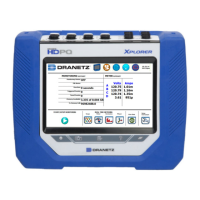4-27
CH 4/ Setup Monitoring
Transients
Transient
detection
Dranetz instruments label rms voltage or current variations as either sags (voltage or
current decreases below low limit) or swells (voltage or current increases above high
limit) as per IEEE 1159. Voltage disturbances which are shorter in duration than typical
sags and swells (which are usually 1/4 cycle or longer) are classified as transients. Two
basic types of transients are:
1) impulsive transients characterized by very rapid changes in the magnitude of
measured quantities and commonly caused by capacitors or inductors switching on
line, loose wires, lightning, static, and power failures; and
2) oscillatory transients defined as a temporary, rapid changes of the waveform. HDPQ
Xplorer has extensive recording capabilities for low and medium frequency transients
using the following trigger mechanisms:
• RMS difference cycle-to-cycle
• Crest or Absolute peak (Instantaneous)
• Waveshape cycle-to-cycle magnitude/duration variation
RMS variations
RMS stands for root mean square, a mathematical formula used to measure the average
voltage and current behaviors. RMS variations result whenever voltage or current
behaviors rise above or fall below the programmed thresholds.
Absolute peak
settings
The crest factor or instantaneous peak is the absolute peak sample value within one
cycle. The instantaneous peak triggers on the absolute peak value of the entire
waveform.
Waveform
capture settings
Oscillatory transients are types of disturbances usually captured as waveshape faults.
HDPQ Xplorer captures pre-trigger and post-trigger waveform cycles. The waveshape
fault triggering algorithm essentially compares the samples for each cycle to the
corresponding samples from the previous cycle. If the samples differ by more than the
threshold tolerance for a length of time exceeding window percent of the power
frequency cycle, a waveshape fault is registered. A trigger occurs when either
waveshape or rms deviation rise outside the programmed thresholds. Waveshape
trigger values include the magnitude and duration of the difference between the present
and previous cycle.
Once a record trigger is detected, instantaneous waveform information is recorded for
the prescribed voltage and current channel(s). Disturbance monitoring requires that
voltage be continuously sampled, and recorded only if the signals exceed specified
values. Waveshape changes are only triggerable for voltage transients as the current
waveshapes are usually continually changing on a normally operating distribution
system. However most types of disturbances require that current be recorded as well to
help determine the source of the disturbance.
Shop for Power Metering products online at:
1.877.766.5412
www.PowerMeterStore.com

